partner
Latest

The best coffee grinder
By Liz Clayton This post was done in partnership with Wirecutter. When readers choose to buy Wirecutter's independently chosen editorial picks, Wirecutter and Engadget may earn affiliate commission. Read the full mirrorless camera for beginners guide here. After over 70 hours of research and hands-on grinding since 2015, we think the uber-consistent, no-frills Baratza Encore is the best grinder for most people. At a practical price, it reliably delivers the high-quality grind needed to make a great cup of drip or French press coffee. The Baratza Encore grinds coffee more evenly than almost any other machine we tested on a wide range of settings. It's a reliable, straightforward tool—there's almost no learning curve—that takes up only a modest square of counter space. It's also super easy to clean and maintain, meaning it'll be an investment you can rely on morning after morning. While it can't produce a fine enough grind for serious espresso enthusiasts, its output is consistent enough for a serviceable shot and should satisfy anyone's filter coffee needs. The Baratza Virtuoso is a great grinder with a speedy, durable burr set and consistent grinding performance. It looks and feels solid, and unlike the Encore, it has a timer switch that makes it easy to grind the exact same amount of coffee each time you brew. It also has a sturdier base than the Encore, which helps keep burrs from vibrating out of calibration, making it more convenient for those who drink a lot of coffee and still demand consistent results. But though the Virtuoso grinds a little faster, its grind is not significantly better than the Encore's—you're paying for incremental improvements. Though it isn't cheap, the OXO Brew Conical Burr Grinder is the best grinder we've found in its price range. So long as you mainly drink drip or French press coffee, the OXO's relatively even grind, wide range of settings, and ease of use make it a good alternative if you can't afford the Baratza Encore, which still offers a more consistent, versatile grind. It's also got some nice features, like a mechanism to reduce static when grinding and a hopper you can remove to change out beans easily—something we still wish Baratza offered. While we stress that hand grinders should be recognized for what they are—good machines to use when electricity is not available rather than cheaper alternatives to electric burr grinders—the Porlex was easily our favorite. Its grinding action is smooth and easy on the hand and wrist, and the grinder itself is durable and compact—it even stows away in the cylinder of an AeroPress if you are traveling. But remember, hand grinders can only make enough grounds for a cup or two of coffee at a time, and that can take 5-10 minutes of manual labor.

The best Qi wireless charging power banks
By Nick Guy This post was done in partnership with Wirecutter. When readers choose to buy Wirecutter's independently chosen editorial picks, Wirecutter and Engadget may earn affiliate commission. Read the full Qi wireless charging power banks guide here. After testing nine competitors over 10 hours, we're confident that Energizer's QE10000CQ 10K Wireless Charging Power Bank is the best all-in-one option for anyone looking for the convenience of a Qi wireless charger at a desk and the portability of a power bank on the go. It also has the fastest ports, and you can charge two devices and the battery itself at the same time. The Energizer QE10000CQ offers better grip on its wireless charging surface than the competition, ensuring that your phone stays in place and keeps charging. It has roughly the same footprint as an iPhone XS but measures about twice as thick, and it's equipped with the best combination of charging options we could find: two USB-A ports (one of which supports Quick Charge 3.0 charging), a Micro-USB input, and a USB-C port for both input and output. (You can fast-charge supported devices through the USB-C port if you have the right cable.) It can fully charge most phones three times before needing to be recharged itself; that's as much battery capacity as we saw from any Qi power bank available during our testing period. myCharge's Unplugged 5K is a good option if you prefer a small, inexpensive charger and are willing to make a few sacrifices. It's more affordable than the Energizer but has half the battery capacity (most phones can get about one and a half to two full charges from this myCharge model). In our tests, the Unplugged 5K wirelessly charged just as quickly as the Energizer, getting a fully drained phone to about 30 percent after an hour. Through the two USB-A output ports, you can expect charging speeds at least twice as fast as with wireless charging, but the unit doesn't offer a USB-C port for even faster charging than that. The white plastic body flexes when you press against it, and this power bank has less grip for keeping your phone in place.
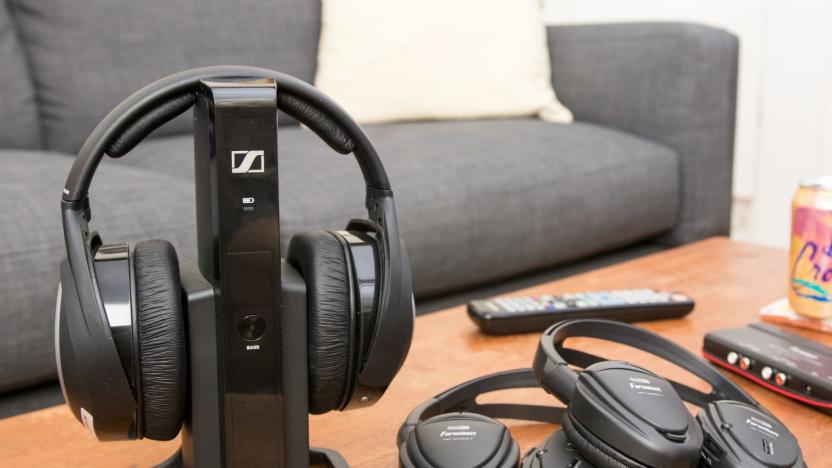
The best wireless TV headphones
By Daniel Varghese and Lauren Dragan This post was done in partnership with Wirecutter. When readers choose to buy Wirecutter's independently chosen editorial picks, Wirecutter and Engadget may earn affiliate commission. Read the full wireless tv headphones guide here. Wireless TV headphones allow you to enjoy TV shows, movies, and video games without disturbing people around you. After spending dozens of hours researching the available options and testing 20 systems, we're confident that the Sennheiser RS 165 is the best one available today. It's easy to set up, sounds much better than the competition, and produces almost no latency between the audio and video (a major problem with many systems). The Sennheiser RS 165 is the best-sounding wireless TV headphone system we tested, and unlike with most of the competition, we didn't detect any noticeable delay between audio and the video we watched, making for the best experience. The lightweight headphones are comfortable to wear, easy to charge, and easy to add to most existing TVs or home theater setups. The rechargeable batteries last long enough to make it through several movies. This system's price has come down a fair amount since we first tested it, which makes it easier to recommend as our top pick. If you plan to use your wireless TV headphones only occasionally and/or you want to be able to use multiple pairs at once, consider the Power Acoustik HP-902RFT. Once you've set up this headphone system, it's as easy to use as the Sennheiser RS 165. However, you have to purchase a separate AC power adapter and at least four AAA batteries first because the system doesn't include those. And the plastic headphones feel cheaply made and aren't as comfortable as the Sennheisers. They also sound a little compressed—you'll still be able to understand all of the dialogue in a movie but the score might sound muffled.
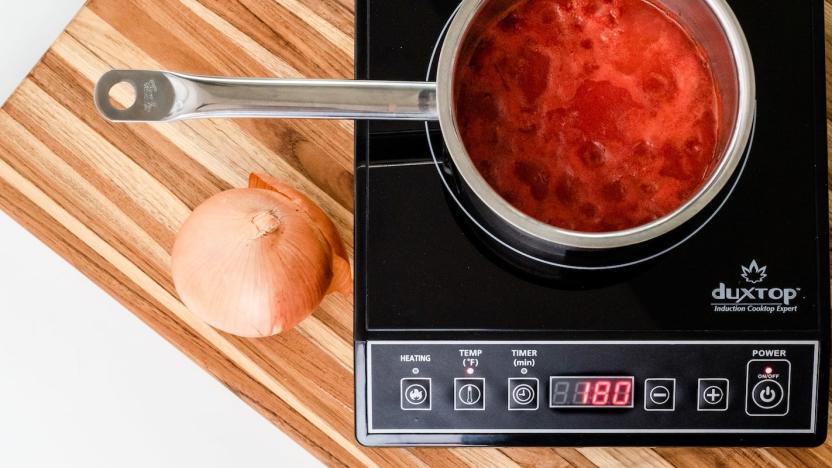
The best portable induction cooktop
By Sharon Franke, Michael Sullivan This post was done in partnership with Wirecutter. When readers choose to buy Wirecutter's independently chosen editorial picks, Wirecutter and Engadget may earn affiliate commission. Read the full portable induction cooktop guide here.

How many smart speakers do you need in your home?
By Thom Dunn This post was done in partnership with Wirecutter. When readers choose to buy Wirecutter's independently chosen editorial picks, Wirecutter and Engadget may earn affiliate commission. Read the full blog on how many smart speakers you need in your home here. Whether you're already one of the 20 percent of American adults who own a voice-controlled smart speaker or you're still on the fence about investing in an Amazon Alexa or Google Assistant device or an Apple HomePod, you might be wondering just how many of these intelligently attentive devices you'll need. A smart speaker can offer voice-controlled convenience throughout your home—but only if it can hear you. The number of speakers you should buy depends on what kind of home you live in, and where and when you'll need your voice assistant to hear you. We have a few suggestions, depending on whether you want to build a smart-home setup, to listen to music and podcasts, to keep in touch with family and friends, or to use a digital assistant to boost your productivity. If you plan to buy multiple smart speakers, we recommend staying in the same family—although you could set up an Alexa-based speaker in one part of the house and a Google Assistant device somewhere else, you'd probably end up forgetting which platform has your to-do lists and which one controls the lights, or you'd have to do lots of redundant setup to get your smart home working with both platforms.
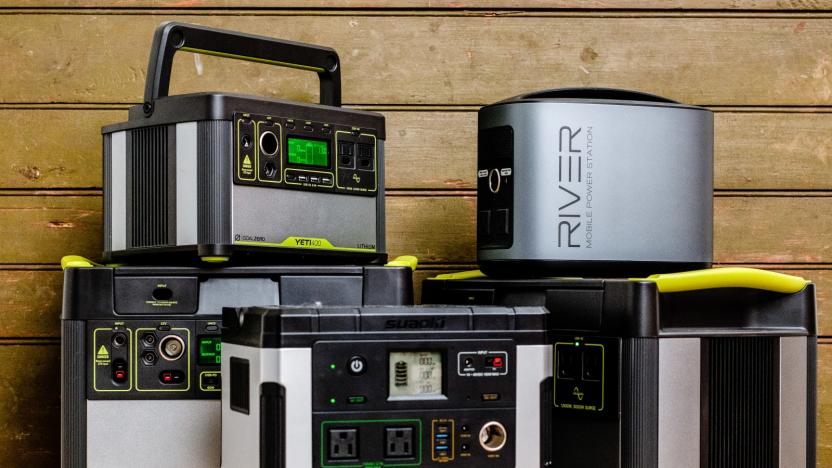
The best portable power stations
By Sarah Witman This post was done in partnership with Wirecutter. When readers choose to buy Wirecutter's independently chosen editorial picks, Wirecutter and Engadget may earn affiliate commission. Read the full portable power stations guide here. If you're planning to go off the grid or you're prepping for an emergency, we recommend the Goal Zero Yeti 1000. This portable power station—a giant battery with regular AC outlets on it—can keep your electronics charged and running for hours without the noise or exhaust that comes with a portable generator. After 35 hours testing five top contenders, we found that the Yeti's impressive capacity of about 1,000 watt-hours, easy-to-use interface, and rugged exterior stood out from the competition.
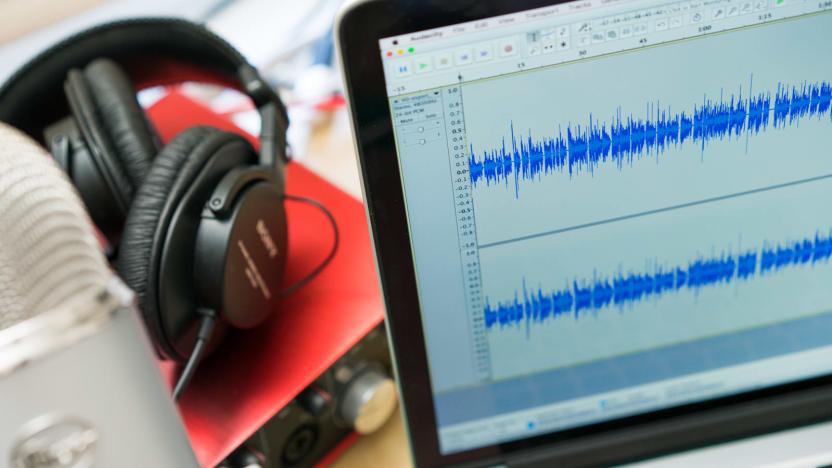
The best audio editing software for beginning podcasters
By Al Griffin This post was done in partnership with Wirecutter. When readers choose to buy Wirecutter's independently chosen editorial picks, Wirecutter and Engadget may earn affiliate commission. Read the full audio editing software for beginning podcasters guide here. After 30 hours spent using and comparing audio editing software, we've found Audacity to be the best all-around option for beginners looking to create their own podcasts. The open-source Audacity runs on Windows, Mac, and Linux computers, and it's free, which eliminates one of the biggest stresses of trying out software. Audacity's user interface is bare-bones compared with that of its competition, including other free options like Apple's GarageBand, but it provides all the tools, features, and support you need to quickly and easily create great-sounding audio productions. It offers, by far, the best value of all the audio software we tested. While recording and editing in Audacity during our tests, we quickly realized that a powerful and feature-packed application lay beneath the software's stripped-down interface. Controls for setting up external equipment such as a USB microphone or audio interface are located in the main window for easy access. The main window also contains panels with everything you need to edit, monitor, and mix audio tracks. In addition, Audacity comes with a sophisticated suite of audio-processing effects to remove the noise, coughs, clicks, and other unwanted sounds that microphones can capture during recording. And although learning how to best apply those effects takes time, Audacity's thorough online manual, tutorials, and support forums will speed you through the process. It doesn't support MIDI or musical-instrument plug-ins, so it isn't the best choice for solo musicians looking to make finished musical tracks, but it is a complete package for anyone who just wants to experiment with recording audio. Like Audacity, Reaper packs a wide range of audio editing tools and audio processing effects. Reaper's interface is more sophisticated, though, and its MIDI-editing features make it a better option for anyone who wants to add their own music to their podcasts, or even for solo musicians/producers looking to make finished tracks at home. Reaper's wealth of features and customization options put it on the same level of functionality as industry-standard digital audio workstations (DAWs) like Cubase and Pro Tools, but at just $60 for an individual or nonprofit license at this writing, Reaper costs about a fifth as much—it's a tremendous deal. Compared with those programs, Reaper is highly approachable and easy to learn, with an extensive library of online help and video tutorials to get you up and running. Once you've learned the ropes of basic audio editing and you're ready to step up your game (that is, take your podcast to a larger audience), we recommend Adobe Audition CC, a powerful platform with an exhaustive range of tools to smooth out and sweeten the sound quality of recorded tracks. Its noise-reduction features in particular are top-notch, and its EQ tools go a step beyond those of the other software we evaluated for this guide. Audition is easy to use, with a clean user interface and a wide range of templates and presets, but it also offers a high level of customization. At $20 per month, or $240 per year, it isn't cheap, but it is the best podcast recording and editing software in that price range. If sound quality is your main concern, Audition is well worth the investment.
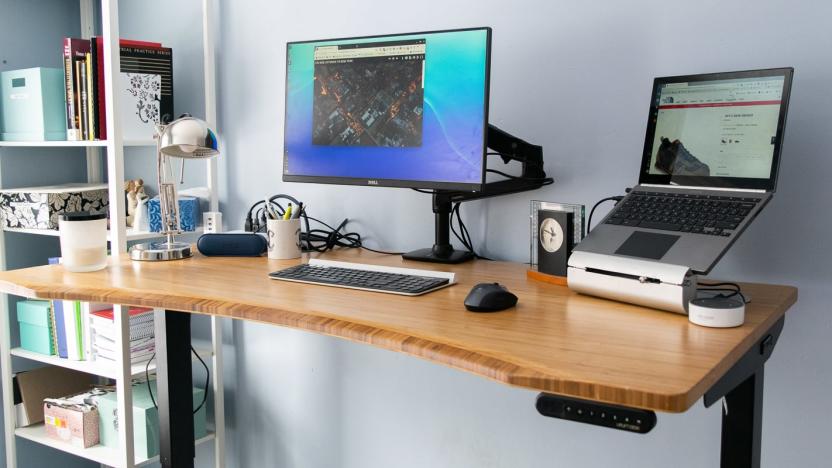
The best standing desks
By Kevin Purdy This post was done in partnership with Wirecutter. When readers choose to buy Wirecutter's independently chosen editorial picks, Wirecutter and Engadget may earn affiliate commission. Read the full standing desks guide here. After two months of unboxing, building, using, testing, and comparing eight of the newest standing desks side by side, we think the Uplift Bamboo Stand Up Desk with 1" Thick Desktop and V2 Frame is the best desk for people who want a relatively stable surface that looks good, moves quickly and quietly, and should give you the fewest problems in working every day. But several other standing desks are nearly as good, and a few are worth considering. The Uplift bamboo desktop was every tester's favorite, particularly the (optional) ergonomic groove cutout in front. You can kit out the Uplift with a number of accessories that match your desk style, including power and cable organizers. It wasn't the best at everything, but the Uplift had the best mix of performance and features, and a lack of glaring flaws, of all the desks we tested. Just make sure you get the V2 frame (Uplift still sells the earlier model, which is a bit less stable). Though the Uplift is not the most rock-solid standing desk we tested this time, it's more stable than the desks we've recommended (and used happily) for years. The desks that were more stable had other flaws, like loud motors or ugly laminate tops. If you want to buy a standing-desk mat and monitor arm at the same time, you should consider the Fully Jarvis Bamboo Standing Desk, because it is a good standing desk that offers those extras in a package deal. The Jarvis was our top pick for more than four years, and is still a desk we recommend. The latest version of the Uplift frame and desktop felt more stable, particularly front-to-back, than the latest Jarvis frame when we tested both in late 2018. But the difference is not enormous; standing-desk stability is hard to measure precisely, and a half-dozen Wirecutter staffers have used Jarvis desks daily for years. The Jarvis's ¾-inch-thick bamboo desktop is thinner than the Uplift's 1-inch top, and looks lighter; otherwise they're nearly identical. In addition to the mat and monitor arm, Fully sells furniture and desk add-ons that mesh well with the Jarvis's look that you can purchase at a discount while ordering the desk, while the Uplift offers small upgrades, like powered grommets and privacy shields. The Varidesk ProDesk 60 Electric is more stable in each direction than the Uplift or Jarvis, and a little bit quieter than those desks in raising and lowering (minus an occasional thudding sound when starting). It also comes with built-in cable management, and was the easiest desk we've ever built. But it has no wood or bamboo desktop options, just five colors of laminate, which our testers disliked. If desktop style is not a high priority for you, and you'd rather pay a few hundred dollars more to have a more stable, quieter desk with easier assembly, the ProDesk 60 Electric could work for you—but we recommend the white or black finishes rather than the faux wood. It was a close call for many of the full-size electric standing desks we tested; several were near picks, except for flaws that will be dealbreakers for some people. Check out our impressions in the Competition section for more. If you're interested in adding a standing adapter to your existing desk, we are researching and testing standing desk converters for a separate review. For now, we still recommend the Kangaroo Pro Junior by Ergo Desktop, which has been our converter pick for four years. It provides a decently smooth and low-effort transition from sitting to standing, it keeps your monitor, mouse, and keyboard more stable than most desktop units we tested, and it doesn't require a very deep desk, or render a big chunk of your desk space unusable except for computer work.
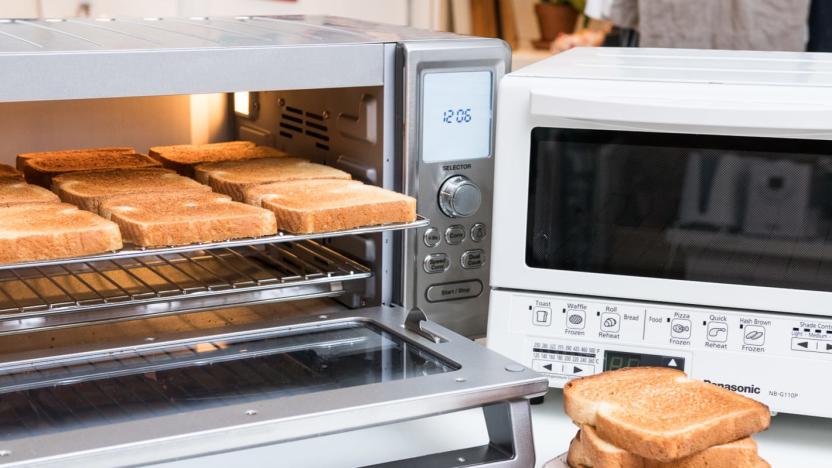
The best toaster oven
By Michael Sullivan and Brendan Nystedt This post was done in partnership with Wirecutter. When readers choose to buy Wirecutter's independently chosen editorial picks, Wirecutter and Engadget may earn affiliate commission. Read the full toaster oven guide here. After more than 90 hours of research and testing—and making stacks and stacks of toast, mini pizza bagels, and cookies—we think the small Panasonic FlashXpress toaster oven and the large Cuisinart TOB-260N1 Chef's Convection Toaster Oven are the best for most people. We recommend the compact Panasonic toaster oven only for small jobs like making frozen snacks, and the sizable Cuisinart toaster oven for everything, including bigger tasks, like baking a pizza or roasting a whole chicken. Both models consistently produced almost perfectly browned toast and evenly baked cookies. They performed as well as (or better than) toaster ovens costing two or three times as much. The reasonably priced Panasonic FlashXpress excels at making toast, cookies, and frozen snacks. In our tests, it cooked food evenly and didn't generate any hot spots that would otherwise cause inconsistent toasting. Impressively, it made toast faster than most of the other models we tried. At around 1 cubic foot in volume, it takes up very little space on a counter, but it's still large enough to fit four pieces of bread or two slices of leftover pizza. We think the Panasonic is best for people who just want to use a toaster oven for toast or other small jobs, like preparing a handful of frozen snacks. For accomplishing bigger tasks, consider getting our other picks, the Cuisinart TOB-260N1 Chef's Convection Toaster Oven or the Breville BOV800XL Smart Oven, which hold nine and six pieces of bread, respectively. The large Cuisinart TOB-260N1 offers nearly all of the capabilities of a full-size oven. It delivers even heat to up to nine slices of bread and can easily handle a 13-inch frozen pizza or a whole roast chicken (whereas our other pick, the Panasonic FlashXpress, can fit only a handful of frozen snacks). The Cuisinart's three-year warranty is outstanding, as are its impressive accessories, which include a pizza stone. Like the Panasonic, this toaster oven was one of the fastest at preheating to 350 °F in our tests. Since it's so large (it measures roughly 20.5 by 13.25 by 11.25 inches), we recommend this model for bigger households that have ample space for a sizeable countertop oven. The Breville Smart Oven BOV800XL, a 1,800-watt convection toaster with the company's Element IQ technology, is a great medium-size model that's more compact than our Cuisinart pick but bigger than the Panasonic FlashXpress. We were impressed by its ability to maintain a set temperature better than most of its competition. It doesn't toast quite as evenly as the Cuisinart, but it bakes cookies and melts cheese well. Compared with the Panasonic, the Breville has a more modern, intuitive interface. However, it is more expensive, lacks an oven light, and doesn't offer a pizza stone like the Cuisinart. The inexpensive Hamilton Beach 31401 toasted bread better than any other toaster oven less than $100. This no-frills model lacks many of the features included in our other picks, such as digital controls and preset cooking features, but it heats evenly. Its humble size makes it ideal for kitchens with limited counter space, but its oven cavity is still large enough to fit four slices of bread. The Hamilton Beach runs cooler than other models we tested, so you'll need to increase the temperature by about 25 degrees when baking or roasting. However, we think this is a forgivable drawback considering its low price.
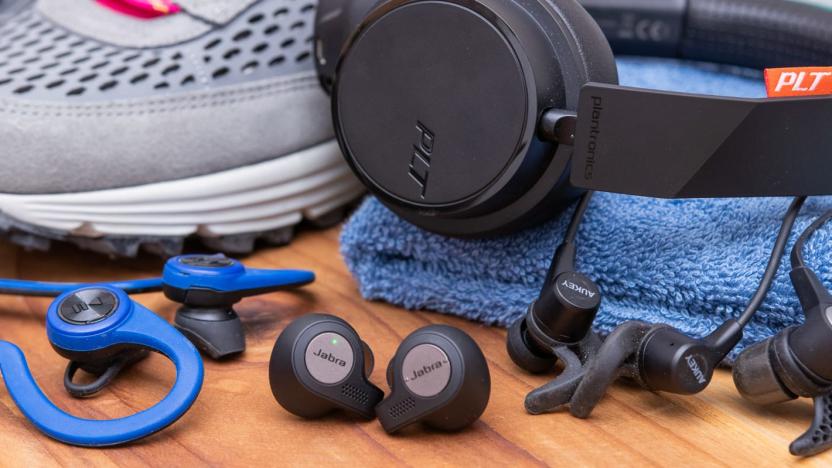
The best workout headphones
By Lauren Dragan This post was done in partnership with Wirecutter. When readers choose to buy Wirecutter's independently chosen editorial picks, Wirecutter and Engadget may earn affiliate commission. Read the full workout headphones guide here. Over the past two years, we've tested nearly 200 sets of headphones designed specifically for working out. Whether you're looking for earbuds that can handle high-impact gym sessions indoors or long-distance jogging outdoors, we have wireless and wired options for gym rats, runners, weightlifters, and swimmers, as well as everything in between. Who this is for: If you use your headphones regularly at the gym, you need workout headphones specifically designed to stay in place through a variety of high-impact moves. Why we like it: The Jabra Elite Active 65t true-wireless earbuds have onboard volume, track, and digital-assistant controls, so you won't need to fuss with your device mid-workout. The adjustable situational-awareness mode allows you to have a conversation or keep an ear on traffic without removing your earbuds. Five hours of battery life per charge is more than enough for most gym sessions; plus, the charging case can store up to 10 more hours of juice (and the rapid-charge function gives you 1½ hours of use from just 15 minutes in the charging case).

The best apps for managing your kid's phone
By Ellen Lee This post was done in partnership with Wirecutter. When readers choose to buy Wirecutter's independently chosen editorial picks, Wirecutter and Engadget may earn affiliate commission. Read the full kids phone management apps guide here. Parental controls allow adults to set limits on their kid's app access and overall phone use and serve as "training wheels" to help kids and teens build healthy tech habits. We spent about 30 hours testing seven parental-control options on both iOS and Android devices, using them to manage our kids' daily screen time, and concluded that Apple Screen Time is best for iOS households, while Google Family Link is best for Android households with kids under 13. Qustodio is the better choice for Android households with children 13 and older. Apple's Screen Time is a free set of parental controls built into iOS 12, the iPhone's latest operating system. It allows parents to manage their child's iPhone or iPad remotely; set a daily limit on the time they spend on specific apps, on categories of apps, or generally on the phone; and automatically limit access to the phone at bedtime. Setup can be confusing, but no other software gives you as much insight into and control over the use of an iPhone or iPad, in part because Apple has such tight control over its software and hardware. Google Family Link is a free app that parents can download on their iPhone or Android phone to manage their child's Android phone. Parents can limit how much time their child spends on the phone, schedule the phone to be inaccessible at bedtime, and block their child's access to the phone with one tap. Google Family Link, however, is usable only for children under the age of 13. Once kids reach this age, they can sign up for a Google account on their own and opt out of monitoring. Though parents can completely block the use of individual apps, Google Family Link does not allow them to set time limits for individual apps. If you're looking for that feature or for parental controls for kids 13 and older, you should consider Qustodio. An annual subscription to Qustodio is the best way for families with kids aged 13 and up with an Android phone to track and manage usage. As with Google Family Link, parents can use Qustodio's app to set a daily overall screen time limit for their child, and block access to the phone with a single tap. Unlike Google Family Link, Qustodio also allows parents to set time limits on individual apps, block out more than one time period when the phone is off limits (such as bedtime and dinnertime), read text messages, and see their child's Web searches.

The best Wi-Fi extender
By Jim Salter This post was done in partnership with Wirecutter. When readers choose to buy Wirecutter's independently chosen editorial picks, Wirecutter and Engadget may earn affiliate commission. Read the full Wi-Fi extenders guide here. After spending more than 50 hours researching Wi-Fi extenders and testing 13, we think the TP-Link AC750 Wi-Fi Range Extender RE200 is the best way to get Wi-Fi signal to part of your house or apartment that your router can't reach. It's inexpensive, and it was the only pure Wi-Fi extender that improved speeds in every single test. But if you have multiple trouble spots or if your router is more than a couple of years old, you should consider replacing it with a mesh Wi-Fi kit instead. The TP-Link RE200 is a dirt-cheap dual-band wireless-ac extender. It improved the Wi-Fi quality in all of our tests, it's easy to set up, it isn't too bulky, and at a typical price of $30, it's a simple fix that costs a lot less than a major hardware upgrade. It was the only Wi-Fi extender we tested that was always better than not using an extender at all. A powerline Wi-Fi access point can sit much farther away from your router than a simple extender, and—when it works—it doesn't interfere with your existing Wi-Fi. In our tests, TP-Link's TL-WPA8630 V2 beat all of the wireless extenders we tested and hung with the more expensive Orbi and Eero mesh kits we recommend. But it's much more expensive than the RE200, and buying any powerline adapter is a gamble since your house's wiring probably wasn't designed to work with it. Older (pre-1980s) and more complex (more than one breaker box) houses tend to be especially problematic. But if you already know your house's wiring is up to par, or if you're willing to experiment and find out, the TL-WPA8630 V2 is the kit to try.
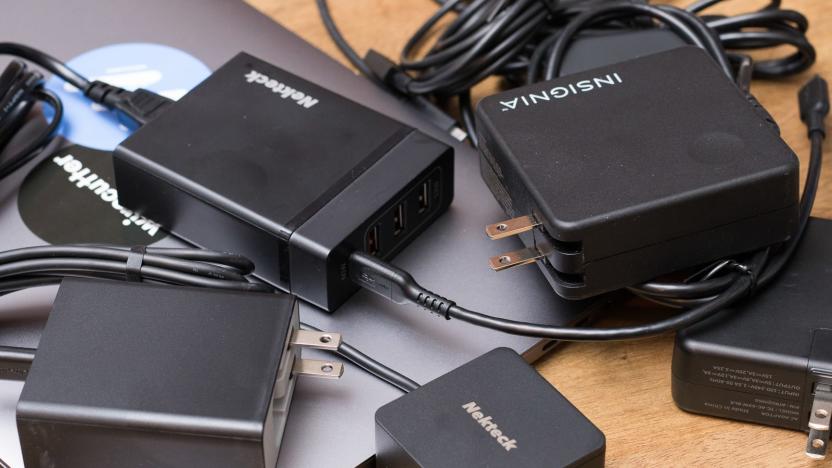
The best USB-C MacBook and laptop chargers
By Nick Guy This post was done in partnership with Wirecutter. When readers choose to buy Wirecutter's independently chosen editorial picks, Wirecutter and Engadget may earn affiliate commission. Read the full USB-C MacBook and laptop chargers guide here. If you need a new charger for your USB-C–powered MacBook or PC laptop, the safest bet is to get the same model that shipped with it. But if the stock charger is difficult to find or expensive, or if you want additional charging ports, we think Nekteck's 4-port 72W USB Wall Charger with Type-C 60W Power Delivery is the best option. We tested 19 USB-C chargers with seven computers and found that the Nekteck charger is powerful enough to charge almost every USB-C laptop at full speed, and it's USB-IF certified, which means it should be safe to use. It also has three USB-A ports for charging other devices at the same time, and it's affordable. The Nekteck charger is one of the least expensive replacement chargers available, yet it works as well as more expensive competitors. It's the same height and thickness as Apple's 13-inch MacBook Pro charger and only about 0.7 inch longer, but it includes three 12-watt USB-A charging ports alongside its USB-C charging port. It also comes with a USB-C charging cable and a long power cord to help you reach far-away outlets. If you don't want the extra USB-A charging ports and would rather have the smallest possible charger for your computer, we recommend Anker's PowerPort Speed PD 60. This 60-watt charger is smaller than what Apple sells but just as powerful, and it's USB-IF certified. You have to provide your own USB-C cable—you can use the one that came with your charger, or buy a new one in whatever length you need. The 15-inch MacBook Pro requires a higher-power—and more expensive—charger. The best replacement is Insignia's Type-C Wall Charger, a 90-watt model that's perfect for the job. It's just a bit larger than Apple's own charger, but it includes a built-in USB-C charge cable for half the price of what a full replacement set would cost from Apple. Like all of our recommendations, it's USB-IF certified. Plus, it's readily available in Best Buy stores across the country, making it an easy pick if you need to grab something today. If you're okay with sacrificing some charging speed in exchange for saving some money, or if you need to charge one of Apple's 2018 iPad Pros (which maxes out at 45 watts), then the ZMI Turbo 45W Wall Charger is your best bet. It still charges at twice the speed of the 18-watt chargers Apple includes with its latest iPads, and it features a detachable (and replaceable) USB-C cable, which our cable testing equipment verified is safe.
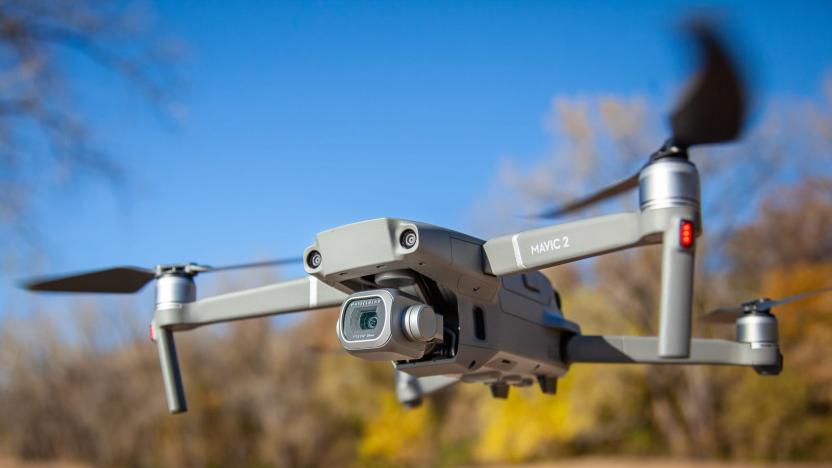
The best drones for photos and video
By Signe Brewster This post was done in partnership with Wirecutter. When readers choose to buy Wirecutter's independently chosen editorial picks, Wirecutter and Engadget may earn affiliate commission. Read the full drones guide here. After 45 hours of research and test flying 14 models, we think the DJI Mavic 2 Pro is the best drone for aspiring aerial photographers and videographers thanks to its high-end camera, autonomous obstacle avoidance, long battery life, and portability. Pilots of all skill levels will find it to be exceptionally reliable and easy to fly. The Mavic 2 Pro features a Hasselblad-branded camera (DJI bought a majority stake in the camera brand in 2017), which captures 20-megapixel photographs and 4K videos that look more colorful than those captured by the competition. Its ability to sense and avoid obstacles in all directions and steadily hold its position even in moderate winds lets you focus on your cinematography instead of worrying about keeping the drone steady. It also features DJI's smart-flight modes like ActiveTrack, which directs the drone to autonomously follow and film a subject while still avoiding obstacles. Its 31-minute battery life means you don't have to land for a battery swap as often as other drones, and at 8.4 by 3.6 by 3.3 inches folded and 2 pounds, you can take the Mavic 2 Pro almost anywhere—it fits exceptionally well in our top pick for drone backpacks. It's also compatible with the DJI Goggles FPV headset we recommend. The Mavic 2 Zoom looks and flies identical to the Mavic 2 Pro, but it trades out the Hasselblad camera in favor of a different camera that can zoom 2 times optically and 2 times digitally (with software that avoids losing detail), for up to 4x usable "lossless" zoom. However, filming with more than 2x zoom will require you to shoot at 1080p instead of 4K. It's a great choice for aerial photographers and videographers who need to work from a distance, whether they're shooting a child's soccer match or wildlife. Like our top pick, it features DJI's obstacle avoidance and smart-flight mode tech, plus a 31-minute battery life and foldable body. If you're just getting into drone photography for personal use and social-media sharing, the DJI Spark is a less expensive model that still includes collision avoidance. Compared to our top pick, the Spark has shorter battery life and range, and it can't capture 4K video (just 1080p), but it weighs half as much and folds up to about the size of your hand. It still includes the important features you need from a video drone, including image and flight stabilization and an included controller, and it has gesture controls and smart-flight modes like ActiveTrack.

Our favorite learning apps for tablets and smartphones
By Courtney Schley This post was done in partnership with Wirecutter. When readers choose to buy Wirecutter's independently chosen editorial picks, Wirecutter and Engadget may earn affiliate commission. Read the full learning apps guide here. We spent over 25 hours researching and testing more than 35 educational and learning apps recommended by educators, experts, parents, and kids. We also studied research from child developmental psychologists and the American Academy of Pediatrics about children's app use and the pedagogical principles for creating learning apps. If your family has a tablet and you want it to be more than a game-playing and video-watching device, or if you're trying to find apps for your smartphone that will do more than keep your kids occupied in a pinch, we have some great suggestions.

The best LED desk lamp
By Anna Perling This post was done in partnership with Wirecutter. When readers choose to buy Wirecutter's independently chosen editorial picks, Wirecutter and Engadget may earn affiliate commission. Read the full LED desk lamp guide here. After consulting lighting and optometry experts, and spending 32 hours researching more than 40 desk lamps and testing 15, we think that the TaoTronics LED Eye-caring Table Lamp (TT-DL13) is the best lamp for most tasks that require focused light. It has the most brightness levels, color temperatures, and adjustability for customizing your lighting, and its light panel has the least glare. The TaoTronics LED Eye-caring Desk Lamp (TT-DL13) has seven brightness levels, with the top level more than bright enough for typical desk tasks; yet no matter how you position the lamp, its frosted panel prevents glare—other, pricier lamps created annoying reflections or bright points of light. It also has one of the most intuitive control panels we've seen, and its slim, unassuming shape looks good on a desk or a nightstand. The Fully Lumen LED Desk Lamp is virtually identical to our top pick—the only difference besides branding is that the Fully weighs a half pound more. But it's more than double the price of our top pick when purchased on its own. It's half off when bought with our pick for the best standing desk, so if you plan to buy both, we recommend buying the lamp from Fully for a one-stop shopping experience. If you're not picky about controlling brightness and color temperature, the IKEA Forså is a classic architect-style lamp with a replaceable bulb that you can swap if you want a different light temperature or color. It's also the most adjustable lamp we tested, and it's available in more colors. Its classic style may work better with different design schemes if you're not into the sleek, modern look of most LED desk lamps.

The best Cyber Monday 2018 deals you can still get
This post was done in partnership with Wirecutter. When readers choose to buy Wirecutter's independently chosen editorial picks, Wirecutter and Engadget may earn affiliate commissions. that support its work. Read Wirecutter's continuously updated list of deals here.

The best Cyber Monday deals 2018: The evening edition
This post was done in partnership with Wirecutter. When readers choose to buy Wirecutter's independently chosen editorial picks, Wirecutter and Engadget may earn affiliate commissions. that support its work. Read Wirecutter's continuously updated list of Black Friday deals here.

The best Cyber Monday 2018 deals
This post was done in partnership with Wirecutter. When readers choose to buy Wirecutter's independently chosen editorial picks, Wirecutter and Engadget may earn affiliate commissions. that support its work. Read Wirecutter's continuously updated list of Cyber Monday deals here.

The best Black Friday deals 2018: The evening edition
This post was done in partnership with Wirecutter. When readers choose to buy Wirecutter's independently chosen editorial picks, Wirecutter and Engadget may earn affiliate commissions. that support its work. Read Wirecutter's continuously updated list of Black Friday deals here.